I’m not sure when it started, but sometime after my husband and I were married, my mother came for Christmas and brought us a panettone for breakfast. Ever since then, this rich, sweet Italian bread has been a part of our Christmas breakfast (along with bagels with cream cheese and smoked salmon). Last year, I decided to try making my own. And now it’s that time of year again!
[Update 12/12: My new Panettone post has some additional tips for making this wonderful holiday bread.]
Panettone is not a bread for the faint of heart. Note I did not say it’s not a bread for beginners, because I believe even those relatively new to bread baking, as I was last year, can have fun and achieve delicious results with this. But make no mistake, it is tricky, and it does require an investment of time and money that not everyone will wish to spend.
And I have rather a lot to say about it, so if you want to keep reading, better grab a cup of coffee and settle in.
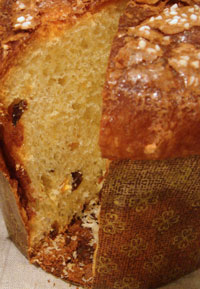 I made three batches last year, each better than the one before, and I was pretty pleased. But the bread still was not quite as light and shreddy as I would have liked. Since then I have had the wonderful opportunity to make panettone in a couple of courses at SFBI, which helped me better understand not only how the bread should be made, but how the dough should feel and handle. As a result, this year’s home-baked panettone (at least this first batch of it) is much closer to my ideal. I know it’s not an option for everyone, but if you have the chance to take a class or visit a bakery and put your hands in the dough, I highly recommend it!
I made three batches last year, each better than the one before, and I was pretty pleased. But the bread still was not quite as light and shreddy as I would have liked. Since then I have had the wonderful opportunity to make panettone in a couple of courses at SFBI, which helped me better understand not only how the bread should be made, but how the dough should feel and handle. As a result, this year’s home-baked panettone (at least this first batch of it) is much closer to my ideal. I know it’s not an option for everyone, but if you have the chance to take a class or visit a bakery and put your hands in the dough, I highly recommend it!
My panettone is adapted from the one I learned in SFBI’s Viennoiserie workshop. The original recipe calls for Italian starter, which is supposed to be kept at 85F and fed every four hours for at least a few days prior to using it. This creates a starter with low acidity that works well for sweet breads.
Well. My vacation time is pretty much spoken for, and I don’t think my boss would count babysitting a lump of flour and water, even in the interest of a lovely bread that he is bound to receive some of, as enough of an emergency to warrant a leave of absence from work.
So I compromised. I converted a portion of my liquid starter to a stiff one (50% hydration), and fed it every 12 hours for a few days, keeping it at room temperature. Then, starting early on the first day of the 2-day baking process, I fed it three times at 4-hour intervals, maintaining it at around 85F.
To ferment the starter, as well as for the final proofing of the panettone at 80F, I placed the dough in the oven with a cup of warm water and a room thermometer. I cracked the oven door open if it got too warm, and reheated the water as needed. When I said “babysitting” I wasn’t kidding. Just like having a newborn in the house again. I think I am way too obsessive about these things.
In addition to the starter, the recipe uses a small amount of yeast. SAF Gold is a special (“osmotolerant”) instant yeast that is especially good for sweet doughs (sugar impedes fermentation when present in high amounts). If you don’t have SAF Gold, you can use regular instant yeast.
The recipe also calls for some other ingredients you might not regularly stock in your pantry. Diastatic malt powder contains enzymes that break down starch into sugars that the wild and commercial yeast can use over the long first dough fermentation; skip it and you risk ending up with a very pale crust. Don’t confuse corn flour with cornmeal or cornstarch. You just need a tiny bit of it for the glaze; I found some in the bulk section of Whole Foods. I couldn’t find whole blanched almonds, and ended up blanching some myself.
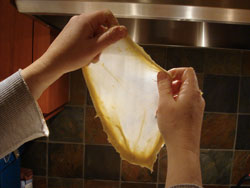 Panettone is an extremely soft, rich, sweet dough. The gluten must be very well developed for the dough to be strong enough to rise high and support all that richness and added fruit. But sugar and fat interfere with gluten development, so these ingredients are withheld from the initial mixing of the final dough, and added in controlled stages. The dough, when properly mixed, yields a paper thin, very translucent “windowpane.” The total mixing time is quite long, maybe up to 20 minutes or even more; it will depend on your mixer.
Panettone is an extremely soft, rich, sweet dough. The gluten must be very well developed for the dough to be strong enough to rise high and support all that richness and added fruit. But sugar and fat interfere with gluten development, so these ingredients are withheld from the initial mixing of the final dough, and added in controlled stages. The dough, when properly mixed, yields a paper thin, very translucent “windowpane.” The total mixing time is quite long, maybe up to 20 minutes or even more; it will depend on your mixer.
Paper panettone molds are available seasonally in many kitchenwares stores, in a variety of sizes. This recipe calls for 5.25-inch diameter molds, which cost me about $0.50 each at Sur La Table.
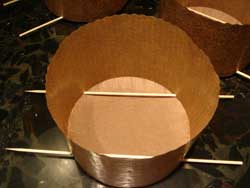 Panettone wants to cave in on itself when it comes out of the oven. Hanging it upside-down for several hours prevents this. Some recipes tell you to pass bamboo skewers through the loaf (mold and all) after baking, from which you suspend the loaves. I found that skewering after baking takes up valuable time during which the loaves are starting to fall. I discovered I could insert the skewers through the molds (just along the bottom) before placing the dough into them, then just bake with the skewers in. To hang the loaves, suspend two dowels between chairs for the skewers to rest on. I had to put mine upon the dining room table so the dog couldn’t get them!
Panettone wants to cave in on itself when it comes out of the oven. Hanging it upside-down for several hours prevents this. Some recipes tell you to pass bamboo skewers through the loaf (mold and all) after baking, from which you suspend the loaves. I found that skewering after baking takes up valuable time during which the loaves are starting to fall. I discovered I could insert the skewers through the molds (just along the bottom) before placing the dough into them, then just bake with the skewers in. To hang the loaves, suspend two dowels between chairs for the skewers to rest on. I had to put mine upon the dining room table so the dog couldn’t get them!
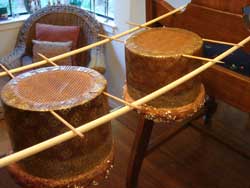
The pannetone can be glazed and garnished with almonds and pearl sugar, or not. I think the adorned ones look beautiful, but if you choose to leave it unglazed, as I did with one of mine, you can cut tuck a pat of butter into a shallow X cut in the top of the loaf just before baking.
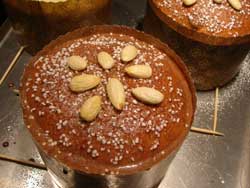
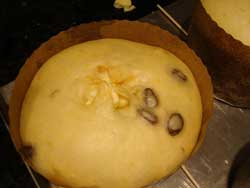
I have heard that panettone can keep for up to several weeks if wrapped well, but I already have short-term plans for this batch of three. And last year we ate one after Christmas that had kept for two weeks; while not inedible, it definitely seemed dry and past its prime. So I’ll be making more in a couple of weeks for Christmas breakfast. I’ve already got the two days blocked off on my calendar.
Panettone
(adapted from SFBI formula)
Yield: about 1500 g (3 loaves)
Time (assumes you are starting with a mature stiff starter):
- Build the starter: 12 hours, at 4-hour intervals
- Mix and ferment first dough: 12.5 hours
- Mix final dough: 30 minutes
- First fermentation of final dough: 1 hour, with a fold at 30 minutes
- Divide, rest, and shape: 25 minutes
- Proof: 4 – 6 hours at 80F, or about 12 hours at room temperature
- Bake: about 40 minutes
- Hang/cool: several hours
Desired final dough temperature: 74F
Sweet Starter Ingredients:
- 20 g stiff (50% hydration) sourdough starter
- 80 g flour, divided
- 40 g water, divided
First Dough Ingredients:
- 346 g flour
- 190 g water
- 1 g instant yeast (osmotolerant SAF Gold, if possible)
- 83 g sugar
- 55 g egg yolk
- 7 g diastatic malt powder
- 83 g unsalted butter, softened
- 86 g sweet starter
Final Dough Ingredients:
- 82 g flour
- 114 g water (you may not use it all)
- 5 g salt
- 82 g sugar
- 25 g egg yolk
- 126 g unsalted butter, softened
- 19 g honey
- 126 g raisins
- 44 g candied lemon peel
- 126 g candied orange peel
- All of the first dough
- scraped seeds from 4/5 of a vanilla bean (use the other 1/5 for the glaze)
- Zest of half a medium orange
Glaze Ingredients (optional; this makes enough for two loaves):
- 55 g granulated sugar
- 3 g ground almonds (or almond flour)
- 4 g vegetable oil
- 4 g corn flour
- 4 g cocoa powder
- 30 g egg whites
- scraped seeds from 1/5 of a vanilla bean
Topping (optional):
- powdered sugar
- pearl sugar
- whole blanched almonds
Special Supplies:
- three 5-1/4-inch paper panettone molds
- six bamboo skewers
Method:
- To build the sweet starter: Mix 20 g stiff starter, 20 g flour, and 10 g water. Ferment for 4 hours at 85F. Discard all but 20 g of starter, and repeat the feeding a second time. For the third feeding, start with 40 g of starter, add 40 g of flour and 20 g of water, and again ferment for 4 hours. Scale out the amount needed for the first dough.
- Mix all of the first dough ingredients just until combined. Place the dough in a covered, lightly oiled container and ferment for 12 hours at warm room temperature (about 72F).
- In the bowl of a stand mixer, combine the flour, salt, egg yolks, orange zest, vanilla seeds, first dough, and about a quarter of the water. Mix in low speed until the ingredients are just combined, about 3 minutes.
- Turn the mixer to medium speed if it has one, mix for a minute or two, then continue to mix while slowly adding the sugar, in about 5 or 6 increments. Mix for one to two minutes between additions.
- Continue to mix until the dough pulls away from the sides of the bowl and the gluten is almost fully developed.
- Turn the mixer back to low speed and add the butter. Mix for a minute in low speed, then in medium speed until the butter is completely incorporated into the dough and the gluten has reached full development.
- In low speed, add the honey, and enough of the remaining water to give you a very soft dough.
- In low speed, add the raisins and candied peels, mixing just until they are evenly distributed.
- Place the dough in a lightly oiled container (preferably a low, wide one, to facilitate folding).
- Ferment at warm room temperature for one hour, folding the dough after the first 30 minutes.
- Turn the dough onto a buttered surface. Divide the dough into three pieces, and form each piece into a light ball.
- Allow the balls to rest (may be left uncovered) for 20 minutes. Meanwhile, skewer the molds as shown above.
- Shape the dough into tight balls and place into the skewered molds.
- Proof at 80F for 4 – 6 hours (or about 12 hours at room temperature), until the dough is risen to an inch or so below the top of the molds.
- When the dough is nearly fully proofed, preheat the oven to 350F, with the rack in the lower third of the oven. If the loaves have been proofing in the oven, make sure to remove them before preheating!
- Optional step: To mix the glaze, whisk all ingredients together. Pour, brush, or pipe the glaze evenly onto the top of the loaves (don’t worry if it pools where the dough meets the mold). Sift powdered sugar over the tops, then sprinkle with pearl sugar and a few whole blanched almonds.
- If you leave the panettone unglazed, use scissors snip an X into the top of the loaf and tuck a pat of butter inside.
- Place the loaves directly on the oven rack and bake for about 35 – 40 minutes, until the tops are dark brown and the internal temperature is 185F. If the tops are already quite dark after 25 – 30 minutes, turn the heat down to 325F.
- While the panettone is baking, set up your hanging apparatus (see above). When the bread is done, hang them as quickly as possible.
- Allow the panettone to hang for at least four hours, up to overnight.
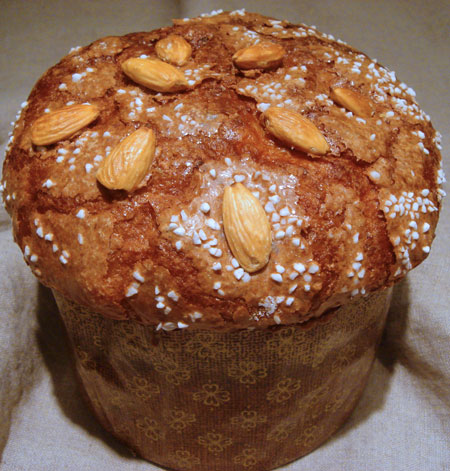
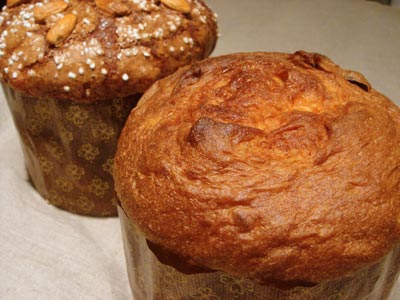
Obsessive babysitting! Maybe. Some would just say it’s attention to detail. It’s where I lose it, I have a hard time with focus. But, it’s also great fun. I guess that’s sort of the sign of a bread baking nut. I’m ok with that.
This is a beautiful loaf (well all yours are) and I’ve been wanting to bake this one. Think I’d better wait till after Christmas to hope for better focus.
What a beautiful job!!! My wife and I lived (and hopefully will again) in Italy for three years and we always looked forward to the Christmas season for these cakes. They stack them in the center in HUGE displays! On the plus side they are only like 3 Euros which is about $4!
These are beautiful! Looks just like they do in Italy!
Oh yeah! Panettone is a huge tradition at our house too. I grew up with is but my husband did not and now he can’t spend the holidays without one. I love the idea of the skewers, much easier than my clownest moves to keep them hanging!!
Yours turned out beautiful!
Very informative post and very nice looking panettone! Thannk you!
Panettone is on my baking list since a long time. Last year I tried Pandoro but I failed. Now I’m a little bit scared. 😉
Panetone is definitely a tradition here in Peru. I tried my hand at some mini ones but for now I will stick to buying the big ones. They are a ton of work! These look delicious!
OMG! It looks delicious, but I am very impatient. I am still going to put it on my list of breads to bake next year. Great recipe!
I baked my first Panettone last year. Your version with the skewers saves time. Very good looking panettone!
Hi Susan,
I was born and raised in Italy and your panettone looks like the ones that come from the best Italian bakeries. Perfect!!
Hi Susan, last year I was going to try a panettone but didn’t make my starter in time — it became a colomba di pasqua instead at Easter. This year I’d like to try again! And I still do have the starter alive and kicking that I from last year. I’d also like to try it with that Italian starter you’re talking about. How does one go about getting that? Thanks!
I do know how to create a biga from scratch — would that work?
Wow! That is quite an accomplishment. I was watching Giada and Mario’s Italian Christmas on the food network this weekend, and they were talking about how no one ever makes panettone at home because it’s so difficult! So I am extra impressed!
Awesome! Not only the panettone is great, but I’m impressed with all the details mentioned. I am going to try this, may I know what kinda flour should I use? I don’t have malt powder, is it ok to use malt liquid?
Tanna, I wish I could put as much focus into, say, folding the laundry…
Lewis, thanks! I’ve been to Italy once, and it was in December, but I was 18 at the time and I don’t think I noticed any panettone. I’ll have to return soon.
Tartelette, it’s so interesting how traditions evolve as families do. Growing up I never thought I would be eating bagels for Christmas, and never even heard of panettone.
Petra, thank you!
Zorra, you should go for it! Even if it doesn’t turn out perfectly the first time I guarantee it will be tasty.
Gretchen Noelle, I love how you shared yours with others. They are lovely.
http://canelaycomino.blogspot.com/2007/12/festive-food-festival-with-132.html
Ben, yes, it really does require planning ahead.
Ulrike, yours came out beautifully!
Manuela, what a nice compliment. Thank you!
Stef, the “Italian starter” is just a stiff starter that’s been fed in the manner I described. So you could use the starter you made last year, if it’s active. Just start feeding it every 4 hours and keep it at 85F.
Katy, I can see why they would say that because it’s not a casual baking project, but it’s a lot of fun anyway.
Olaf, there are two kinds of malt, diastatic (enzymatically active) and non-diastatic. You need diastatic for this, which may come in syrup but I’ve never used that so I can’t advise you. The diastatic powder is available from King Arthur Flour and Amazon, and I’m sure there are other sources also. I used the same flour I usually use for all bread. Please let me know how yours turns out!
Wow Perfect !
Great recipe,thank you for Sharing.
we have tagged you for a Meme, only if you want to do it, and we hope you haven’t done it already .
zainab & meedo
Just lovely! What an accomplishment, for sure.
A family friend (who lived in Italy for 30 years, was married to an Italian cook-at-heart) gives us big panetonnes every year. We use it to make Christmas trifle, a blending of the two families, I figure.
Zainab & Meedo, thank you for thinking of me! I would like to do it, but it may be in few days.
Alanna, I love the idea of using panettone for a trifle.
Susan,
I made this recipe yesterday. A more detailed account at: http://www.thefreshloaf.com/node/5232/panettone
I needed less than half the water. The result was quite incredible. Thanks for the instructions.
Dolf, very nicely done!
Hi Susan
I posted this question on Dolf’s post at the Fresh Loaf, but I figured I’d cross posted here as well…
I’ve been doing the 4-hour feedings today for the Italian starter. My stiff starter does generally quadruple in 8 hours, but not in 4. It’s maybe doubling. Is it active enough to proceed, do you think? Ordinarily I’d just do more feeding cycles, but obviously not going to work with the Christmas deadline coming up.
Do you think the starter is strong enough to proceed if it’s only doubling or so every 4 hours?
Maybe I should just fall back on Carol Field’s yeasted recipe…
Happy Christmas to all!!
Helen, I know you’ve gotten this all nicely figured out by now but in case anyone else is curious, yes, if the starter is doubling it’s fine.
Hi Susan
I FINALLY got around to recording my panettone-gazing for posterity. Pictures of mine are at the bottom. Thanks many times over for all your help!
http://helenskitchen.blogspot.com/2008/01/adventures-in-panettone.html
Helen, beautiful, beautiful! You said you used high-gluten flour, and I used a proportion of it in my second batch. It worked really well, so I’m going to make this a permanent modification in my recipe. I’m already looking forward to next year’s!
I know… I’m thinking there’s going to have to be some kind of thinly-veiled panettone-like thing for Easter. Just have to figure out what to call it.
Helen, how about making Colomba di Pasqua for Easter? I’ve not made it before but I believe it’s somewhat similar to Panettone, and traditional for Easter.
Sounds like an excellent idea. I’m in. I’ll let you know how it goes!
Thanks for such a detailed explanation, the photos were really nice. You inspired to bake one this year, I tried the Simili sister’s natural leaven (no commercial yeast) and it turned out great. I put up a photo at http://www.thefreshloaf.com/node/5361/panettone.
Some of the recipes call for “wrapping” the starter in parchment or plastic and twine during its builds so it “bursts” the container. I noticed the recipe you posted just builds the starter normally; my guess is that would fine and the other is just a custom or myth.
Jkandell, really nice loaf! My understanding is that there is some basis for wrapping the starter: to trap carbon dioxide in the dough, which inhibits acid production and makes the starter sweeter. Obviously I didn’t do this.
Thank you so much for your recipe!!
I have tried to make pannettone several times, with so-so results and a strong yeasty flavor. But this one was amazing! Beautiful texture and taste!
This is my first experience with a starter and I just love it 😉
Very tasty, recipe well detailed (I did not know how to check the gluten level before)
Thank you!
Hi, Susan!
Congrats! Great recipe. tryied at my restaurant (“La Botticella” in Rio de Janeiro) turbo oven and came up just great. My wife and I plan to prepare a large quantity of small panettoni to present our customer next December as a small Christmas gift. Any detail we should consider for the task?
Thanks a million, John
Dear Susan , your blog is awsome, I like all of your recipes , you are such an accomplished baker, I would like to make your panettone recipe, but I have never make starter at home before, you mentioned italian starter , do you mean”biga”, I would like also to learn your way to prepare starter at home, would you please show me where can i read it??Thank you so much and have a nice day!
A baker after my own heart – I made panettone for the first time last Christmas and it was okay, but not stellar. I’m also experimenting with stollen recipes; there is something about fruit laden Christmas breads that I love. Anyway, do you have a SF Bay Area source for the SAF Gold? I think I have some in the freezer from last year from KA, but I should probably buy a fresh package. Thanks for the recipe and tips!
Kris
Hi, thanks for post, I have been searching for something like this for years, but yours looks like the closest to the real thing yet. I tried your recipe over the weekend, I think I rushed the starter a bit and used a baking tin instead of the paper moulds, but that did not seem to work as well. I see you now have a chocolate one using a handmade paper basket. I will give that a try. Thanks again for posting this and keep up this great blog!
Hi,
after i looked around in the Internet to find a nice Panettone recipe i decieded to try yours.
It worked really perfekt for me 😀
I had just some troubles to cool them upside down, because they left their folded paper baskets (like the ones you use for the chocolade panettone).
But the taste is incredible! Very soft and airy!
Thanks a lot for that perfekt recipe.
Greetings from Germany
Stefanie
Susan:
A good friend of my wife’s from Switzerland always talked about how much she liked these. I had never had one, so picked up one from the store this winter to try and understand what sort of thing I was getting into. It was nice and light and soft, so when I saw your recipe (a sourdough version!! – my favorite breads, the scientist in me loves this stuff) I just had to try it.
I mixed the final dough this morning by your recipe, and found that I didn’t need to add any additional water – in fact, I am concerned that the dough is too wet. Is yours usually very sticky? I am confident that I measured everything accurately, but am concerned about the moisture level. I will let you know how it turns out. Thanks.
Greg
Thanks Susan, 12 little babies made as close as can be to your method here are hanging upside down in the kitchen tonight. Never made this before. I think you are their fairy godmother 🙂
Awesome. Very close to the panettone of South American dreams. Loved the shreddy texture. I thought it was a bit too sweet though.
I don’t have a stand mixer so I mixed it by hand, but not as many minutes.
Hi Susan. I am given up on making panettone a few minutes ago. I don’t have a stand-up mixer, so I decided to try mixing the ingredients by hand. This morning, when I poured the first dough into the second, I realized that it was lumpy, something I did not notice last night when I put it to rest. So I tried a measure of last resort (which I won’t go into detail) with the result of an even softer dough, even before adding the butter. So I decided to stop and maybe borrow a stand-up mixer and give it another try in the future. In going through the recipe, though, it seems to me that 82 g of flour as part of the second dough is a very small quantity. Before the misconceived move that totally ruined my dough, the consistency was very soft. Maybe that was the result of flour not being properly mixed before, but I thought I would ask. Also, may I ask what kind of flour you are using now? Thanks!
Simona, it is important in the mixing of the dough that the sugar be added very slowly, otherwise the dough will be soupy and the gluten will not develop. I have not mixed this by hand but I think it would take a very long time to do. Also note that not all of the water is added at the beginning, and you ay not need all of it in the end either. The 82 g of flour is correct. I use my regular bread flour: http://www.wildyeastblog.com/2008/06/23/flour-101/
Thank you so much, Susan! I will take all your advice into account when I try again.
Oh boy! I am the one who is lending Simona a stand mixer. So, even though I don’t eat wheat, I fully intend to enjoy the vicarious thrill of being part of the process. Happy Holidays!
Hey thanx for sharing this recipe. My mouth started watering after seeing this. I am going to try this today.
Keep on posting like such a great kind of recipes
Susan thanks again for posting the recipe of the Colomba.
I just finished the “babysitting” and it is absolutely divine.
Roberto
Have you ever tried using high gluten flour for your panettone and colomba, and pandoro? Using the Cresci book again, I found I got a very light, thready finished product. Also for those who don’t add all the water on the final dough, I found that it is better to do the double hydration method. After you have added the eggs and butter, fully develop the gluten, then add the water. It will be very soft, but still have the great windowpane. You should try Panettone with Gianduia chocolate from Cresci. The people I gave it to, loved it. I found a company online that actually sells the hazelnut paste and gianduja paste in small quantities.
Still love the blog, you do great work
That looks really Italian!
Susan, what kind of mold is it? Special paper mold?… Actually I make translation of these recipies into russian for my friend who deals with bread, but I am so interested in it, that I am eager to bake some myself))!!
Oh my God! I just finished reading this recipe and I´m in love with it. I love Panettones and tried sometimes 15 years ago. But that time, there wasn´t any internet. The only references was from televisions and some cooking magazines. And the results were always the same: hard, like a rock (I´m kidding, I could eat them all, but that wasn´t like the ones I used to like, sold here in Brazil). So, unemployed, I´ve been trying lots of things in my kitchen, and as long as Christmas is near, I thought about doing Panettones. I did one today, I don´t know if I failed or the recipe wasn´t good enough. I do believe in the second option, since the proportion between liquid and flour seems to make it really dry and heavy. Well, I just want to thank you for this contribution and hope I could do well this time, even though I do not have a kitchen weighing machine (I make some proportions related to the flour and sugar density and uses the volumetric scale). Well, better it works finely, or else, I will have to eat the industrialized ones this year. Cheer!
Hello Susan. Thank you for sharing your recipe and amazing techniques! I have one question though. What is the purpose of shaping the final dough into a loose ball and resting it 20 minutes before tightening it for the mold?
Thanks!
Hi susan I am from south america and I think it will get the malt powder or could be replaced by something else or I can circumvent it and greetings thanks great recipe and explanation
Hola!
La receta nos parecio buenisima, muy detallada ,pero por favor ,habria posibilidad de pasarla a castellano.
Gracias!!
Hector, if you don’t have malt powder you can leave it out; your crust might be more pale, though.
Osvaldo, lo siento, no tengo bastante español para traducirlo. Recomiendo translate.google.com 🙂
hi Susan,
i don’t know if you’ll see this comment but given that xmas is approaching, i’ll try my luck.
Just a question on the texture and keeping quality of your panettone. I made a yeasted version last yr, and while it tasted great it didn’t keep well. Within two days, it had gone very dry and hard. Not unusual i know, and it’s quite a tradition i believe to have dried panettone for breakfast.
However, last year i had the greatest fortune of trying a panettone imported from Italy. I can’t remember the name of the bakery but they were a specialty bakery with a long tradition of making these. In fact, if my memory serves me well, i think that’s all they make. Believe me when i say they were out of this world. Taste-wise, texture-wise, they were top notch. And i noticed they remained soft and pillowy for days and days!! Now, i wonder if you know the secret to that. I am going to go out on a limb and attempt your recipe this year (Thank you!) but was wondering for how long they retain the moistness before drying out. This is also to plan my baking in order to give them away.
Your help is much appreciated and thanks once again for your recipe. Your blog has always been a reference for me.
To all who want to try the panettone: get a mixer is my advice. I tried kneading by hand – not this recipe! – (with the very stupid notion that like this, i could avoid using and washing the mixer) and it took me 50 MINUTES. that’s right. 50 mins of kneading, slamming and flinging the dough, sweating and much much swearing. The dough was as sticky and wet as they come, but eventually came together, but not before there was dried fruit flying in all directions and dough on every conceivable surface. I later read on the Internet that traditionally panettones are kneaded for that long by hand in Italy :))
Thank you susan for the recipe. Actually I will try to do it this year but with little changes. I will attempting to make vegan Panettone. My question to you is the measurement of of eggs. I don’t know how to measure the eggs in grams, I will use egg replacer so if I can get the actual numbers of how many eggs is used in each dough. Thank you again
w, I usually bake the panettone close to the time it will be eaten, but I think I have kept it uncut and wrapped for up to a couple of weeks. It might keep longer. Once it is cut into, it is gone within a day, so I can’t comment on how long it would keep once cut 🙂
Nabil, eggs are one of those things that vary greatly in size. A single whole egg (without shell) can weigh anywhere between 40 and 70 grams. The “large” eggs I buy in the store used to be around 50 grams, now they’re more like 55. This is why I recommend weighing if at all possible. Here is a post that may be helpful: http://www.wildyeastblog.com/2009/04/20/do-it-yourself-conversions/
Good luck with the vegan panettone!
What are the ingredients in the imperial system? I don’t have a scale.
Do you think semolina flour would work well for this recipe? It’s all we have at the moment, it’s supposed to have a protein content similar to bread flour.
What’s your opinion of mixing it up and then dividing the dough into mini panetonnes using a muffin tin?
I would like to thank you for sharing this recipe and the technique. I am learning a lot with yours instructions. Today I am baking my very first panettone.
Hi!! I just wanted to thank you for your recipe, it was a big basis for mine. I made 9 kgs of Panettone last week and they were a complete succes. The post is in my blog, english version coming soon. Thank you again!!! http://www.monitouille.com/panettone
http://www.monitouille.com/en/panettone
Susan,
I have just placed my dough balls in the panettone cups for their final step. I do have a very loose dough though which was sticking to my hands. I added more flour to tighten it up since I wanted to salvage this one week obsession. I do have a stand mixer and I make pizza dough every week. I used both the dough hook and the flat paddle. The flat paddle had basically the entire dough all wadded up and not mixing and the dough hook did not mix well either and was not pulling the dough away from the sides like I get with my pizza dough. Any suggestions you may have to help would be greatly appreciated. I really enjoy your blog and want to perfect my bread making, especially panettone since my wife loves the bread so much.
Also, my final dough is not rising. I have had it in the oven for about 4 1/2 hours and it is still about the size it was when I placed it in earlier.
Susan,
The loaves have cooked and the are very small. The final proof did not happen. Still, it is my best effort to date by far. I am new to bread baking and just want some specifics about the problems I am running into. So, problem one was final dough was too loose and so I added more flour to tighten it up. Problem two was that my final dough did not proof and the loaf was way too dense. I have learned so much from your blog in the past two weeks so maybe I am pushing my luck with this need for additional info. Still, if figure it doesn’t hurt to ask.
Michael, adding more flour will make your panettone dense. This is a loose dough that is difficult to work with, and it is tempting to add more flour, but resist it! The dough does need to be mixed properly, with the sugar added VERY slowly, in order for the gluten to be strong enough to support the richness of the dough. I suspect this was your problem. Also, if you got no rise whatsoever, your yeast may be old, or your starter not active enough. I encourage you to try again. This is a difficult bread, but very satisfying when it comes together!
I will try and thanks for the incite. I love the blog and I am glad you responded. I am new to bread making but I have the desire. I will mix it more and be more mindful of the starter.
Hi! Great hints…except one! My upside down panettone came CRASHING to the floor! *SPLAT* I put the skewers in exactly as you did, very close to the bottom. Has this ever happened to you? (Boy did that messed up panettone make amazing bread pudding!) Please advise?
John – oh no! This has happened to me on occasion — I think it was when I was maneuvering the panettone onto the hanging rack and supported it by just one of the skewers. I’m sorry that happened, but glad you enjoyed the bread pudding!
Susan,
I took my starter out of the frig and fed it in preparation of making another run at being successful. It doubled quickly but then settled down. Is this the way is should behave or should it hold its growth? I ordered SAF yeast to make certain that my yeast is fresh. Does my starter sounds active enough?
I started with regular bread machine yeast and left it in the fridge for two days, after first mix with a stick of butter, some honey, an egg and some salt. THen, I added some citron, golden raisins, candied orange peel and some dates with three egg yolks more honey and vanilla, then baked it in a parchment flute and it came great. Thanks for all the details 185 temp especially.
Hi Susan. You have a wonderful website. I am completely new to bread making (I mostly bake sweets and quick breads), but I decided to try your panettone. The first and final dough came together just fine and it rose during fermentation and final proofing, but failed to rise any more during baking. It was still tasty and somewhat light and airy but I’m at a loss as to why it did so well in rising during the whole process except for baking. Thank you for your help.
Jennifer, congratulations for taking on an advanced bread! It’s hard to know why your panettone did not have “oven spring.” It could have proofed too long during the final proof before baking. Perhaps your oven temperature was too high, causing the crust to set before it could rise further. Make sure your molds are the right size for the amount of dough you are using. If they are too large, the dough will not rise above the top.
Hi, this recipe sounds wonderful, and I will be attempting it the minute I start my christmas holidays.
One question I’m not clear on – do you use all-purpose flour or the ‘strong’ flour usually used for bread baking?
I know there are different ways of calling these things in the US vs UK (where I live) so for context, my ‘strong white bread flour’ has 12.9% protein, which is quite high. And my ‘plain’ all-purpose flour is 10.4% protein which is quite low.
Which do you recommend for panettone (or should I use a mixture of both)?
Thanks for your help. M
Success!!. After failing 5 times, I finally produced real panettone from my home. I mixed the dough for about an hour but who cares. I was really quite impressed with myself and my family was as well. Feeding my starter for two days at 4 hour intervals was the one thing I refused to do until this attempt. Pay the price for cutting corners on this bread.
Hi,
I am from Australia, just wondering, when you say that you used corn flour, is this flour made of ground corn (corn meal)? Corn flour in our terms is probably a bit closer to cornstarch I think…
Joanne, yes corn flour is flour made from ground corn. However, it is ground more finely than cornmeal; the grind resembles that of regular (wheat) flour.
Mattski, here’s some information about flour: http://www.wildyeastblog.com/2008/06/23/flour-101/
Michael: yay!
I thought I’d share my idea about how to keep your proofing container or oven at 80° to 85°. What I’ve come up with has been working quite well. I purchased a 25 W fish aquarium heater adjustable from 68° to 93° I inserted this into a 1 gallon bottle of water and placed it in the oven. Price of the heater was about $16.
Happy baking all.
Dave V
Hi Susan,
I did some digging around looking for a sweet sourdough starter and came up with this. It’s called Herman sourdough starter.
http://allrecipes.com/recipe/herman-sourdough-starter/?scale=2&ismetric=0
What you think.
Thanks
Dave V
Everything turned out great tell I turned it upside down!!! Made the fatal mistake of putting in too many goodies extra raisins candied fruit cherry chips. The proofing went perfectly. Well I’ll definitely know better next time. For what that didn’t fall on the floor the bread was excellent.
Dave V
I’ve just stumbled on your site, and what you are describing very much resembles Russian traditional Easter bread, called “kulitch”. Never made it, but now I’ll try! Thanks! You make it look really delicious.
Hi Susan
Fantastic website…thanks so much for sharing. Your panettone looks spectacular but I just don’t have the patience for all that ‘babysitting’. KISS – Keep it Simple Stupid – is my motto! I’m always modifying recipes. Thanks for the tips on using leftover sourdough btw – your banana loaf looks great.
So I took info from four different sourdough and commercial yeast recipes and came up with a SIMPLE SOURDOUGH one that bowled me over by producing a perfect panettone … soft, delicate, moist, divine!
And I just used my usual 100% hydration starter – and no salt.
My lucky work colleagues got to sample straight from the oven today. One being Italian said it was better than any imported Italian panettone he’d tasted (full of preservatives and who knows what, of course) but I’ll take the compliment – Grazzi 🙂
My friends keep telling me to write a book with all my wild (and healthy) modifications. Maybe I need to patent my recipes – someone told me that just by publishing on the web that equals patenting. Anyone know if that’s correct? Susan?
“It is a long day, a day without bread”
Amen to that!
Karen